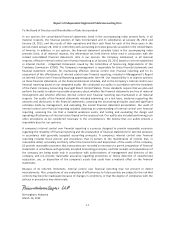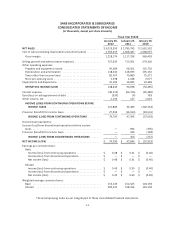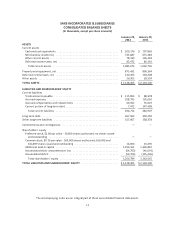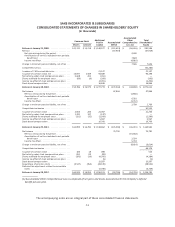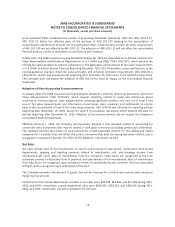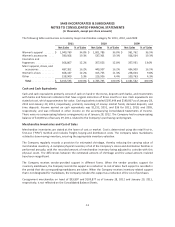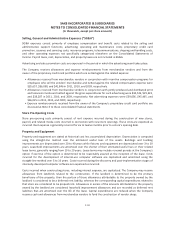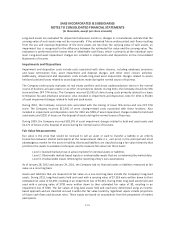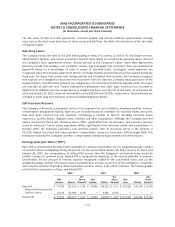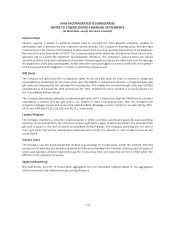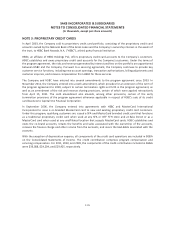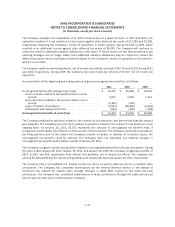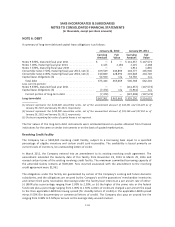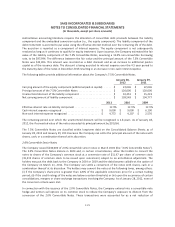Saks Fifth Avenue 2011 Annual Report Download - page 56
Download and view the complete annual report
Please find page 56 of the 2011 Saks Fifth Avenue annual report below. You can navigate through the pages in the report by either clicking on the pages listed below, or by using the keyword search tool below to find specific information within the annual report.SAKS INCORPORATED & SUBSIDIARIES
NOTES TO CONSOLIDATED FINANCIAL STATEMENTS
(In thousands, except per share amounts)
Long-lived assets are evaluated for impairment whenever events or changes in circumstances indicate that the
carrying value of such assets may not be recoverable. If the estimated future undiscounted cash flows resulting
from the use and eventual disposition of the store assets are less than the carrying value of such assets, an
impairment loss is recognized for the difference between the estimated fair value and the carrying value. The
evaluation is performed at the lowest level of identifiable cash flows, which is primarily at the individual store
level. Long-lived asset impairment charges are included in impairments and dispositions on the Consolidated
Statements of Income.
Impairments and Dispositions
Impairment and disposition costs include costs associated with store closures, including employee severance
and lease termination fees, asset impairment and disposal charges, and other store closure activities.
Additionally, impairment and disposition costs include long-lived asset impairment charges related to assets
held and used and losses related to asset dispositions made during the normal course of business.
The Company continuously evaluates its real estate portfolio and closes underproductive stores in the normal
course of business as leases expire or as other circumstances dictate. During 2011, the Company closed one SFA
store and two OFF 5TH stores. The Company incurred $5,065 of store closing costs primarily related to a lease
termination fee and employee severance. Also included in impairment and disposition costs for 2011 is $5,041
of asset impairment charges related to held and used assets.
During 2010, the Company incurred costs associated with the closing of seven SFA stores and one OFF 5TH
store. The Company incurred $12,045 of store closing-related costs associated with these locations. Also
included in impairment and disposition costs for 2010 are $785 of asset impairment charges related to held and
used assets and $255 of losses on the disposal of assets during the normal course of business.
During 2009, the Company incurred $28,176 of asset impairment charges related to held and used assets and
$1,172 of losses on the disposal of assets during the normal course of business.
Fair Value Measurements
Fair value is the price that would be received to sell an asset or paid to transfer a liability in an orderly
transaction between market participants at the measurement date (i.e., exit price) in the principal and most
advantageous market for the asset or liability. Assets and liabilities are classified using a fair value hierarchy that
prioritizes the inputs to valuation techniques used to measure fair value into three levels:
Level 1: Quoted market prices in active markets for identical assets or liabilities
Level 2: Observable market-based inputs or unobservable inputs that are corroborated by market data
Level 3: Unobservable inputs reflecting the reporting entity’s own assumptions
As of January 28, 2012 and January 29, 2011, the Company had no financial assets or liabilities measured at fair
value on a recurring basis.
Assets and liabilities that are measured at fair value on a non-recurring basis include the Company’s long-lived
assets. During 2011, long-lived assets held and used with a carrying value of $7,533 were written down to their
estimated fair value of $2,492, resulting in an impairment loss of $5,041. During 2010, long-lived assets held and
used with a carrying value of $785 were written down to their estimated fair value of $0, resulting in an
impairment loss of $785. The fair values of long-lived assets held and used were determined using an income-
based approach and are classified as Level 3 within the fair value hierarchy. Significant inputs include projections
of future cash flows and discount rates. These inputs are based on assumptions from the perspective of market
participants.
F-11



